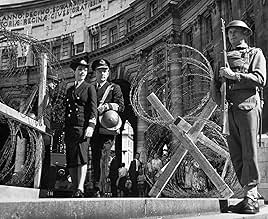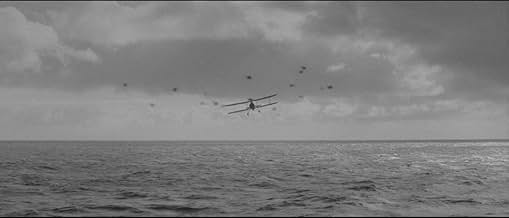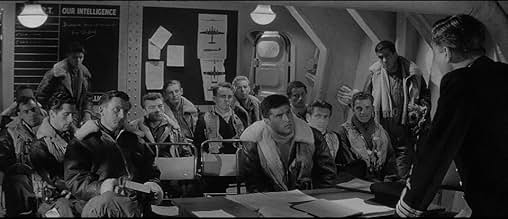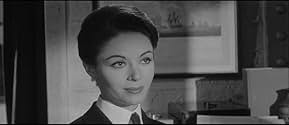IMDb रेटिंग
7.2/10
8.8 हज़ार
आपकी रेटिंग
अपनी भाषा में प्लॉट जोड़ेंThe World War II story of the Royal Navy's effort to defeat Nazi Germany's most powerful warship.The World War II story of the Royal Navy's effort to defeat Nazi Germany's most powerful warship.The World War II story of the Royal Navy's effort to defeat Nazi Germany's most powerful warship.
- पुरस्कार
- 2 कुल नामांकन
Carl Möhner
- Kapitän Ernst Lindemann
- (as Carl Mohner)
Jack Gwillim
- Commodore Wilfrid Patterson - HMS King George V
- (as Jack Gwillam)
फ़ीचर्ड समीक्षाएं
This movie is a well crafted and gripping depiction of British attempts to locate and destroy the German battleship Bismarck during World War II. It is told from the viewpoint of sailors aboard vessels from both sides and also the British naval command headquarters. I have little knowledge of naval history so am in no position to comment regarding historical accuracy.
Personally, I found most compelling the strategy and tension within the Admiralty War Headquarters in London, especially the personal depiction of the coordinator of this operation. Kenneth More convincingly plays Captain Jonathan Shepard, who lost his own wife earlier in an air raid and has a son who is himself a naval pilot involved in the battle to sink the Bismarck. Shepard's relationship with the lovely but very professional female naval officer Davis is well captured. There is also a moving portrait of Shepard's restrained response to unfolding news regarding his son. Though there is engaging battle drama at sea, it's the character portrayal of this stiff upper lip British officer that made the movie for me.
Personally, I found most compelling the strategy and tension within the Admiralty War Headquarters in London, especially the personal depiction of the coordinator of this operation. Kenneth More convincingly plays Captain Jonathan Shepard, who lost his own wife earlier in an air raid and has a son who is himself a naval pilot involved in the battle to sink the Bismarck. Shepard's relationship with the lovely but very professional female naval officer Davis is well captured. There is also a moving portrait of Shepard's restrained response to unfolding news regarding his son. Though there is engaging battle drama at sea, it's the character portrayal of this stiff upper lip British officer that made the movie for me.
and could just watch and enjoy the movie without analyzing it. That's what movies were originally for - entertainment and enjoyment. I don't know if the special effects were great for the time or not, but they looked enough like the real thing for me. Great naval battle scenes and the acting was perfect for the times portrayed of the 1940's and the real way that military people are mostly low key in planning discussions and carrying out their duties. All very believable scenes with the flavor of the way it really was even in portions that were added to entertain (when history takes a back seat to entertainment). Kenneth More showed his versatility in excelling in such a serious part and Dana Wynter very professional. I don't know why she didn't become a larger name here in the States with such pure beauty, grace and honest acting ability. By coincidence I just saw her in another movie In Love And War where she played a totally different type of part and nailed it great. Anyway, if you haven't seen Sink The Bismarck, then by all means give it a gander. It is time well spent for not only those who enjoy naval movies, but good drama films as well.
The German battleship Bismark was one of the finest warships ever built. She carried 8 15-inch guns and a powerful secondary battery and could make 30 knots. It wasn't one of the biggest or most powerful battleships ever built. The Japanese had the Yamato and Mushashi towards the end of the war, juggernauts with 18-inch cannons. There's a limit to gigantism of course, and in the case of battleships it had to do with whether they could fit physically through the Panama Canal, a concern the Japanese had long put behind them. So the Bismark wasn't the sort of sacred monster that sheer size would make her. But she LOOKED absolutely great. Sleek, well balanced, with her superstructure done the way an architect might have done it, not an engineer. She looked built for speed, and endurance too. For an example of the opposite trend, take a look at Rodney or Nelson. More powerfully armed, with 9 16-inch guns carried in three turrets, all set forward of the superstructure. Man, that is one ugly design. And, more than that, Bismarck's crew were highly trained and she was equipped with one of the world's best optical fire-control systems. It wasn't just luck that sank the Hood and damaged any smaller ships that go too close; it was good shooting. (Her shooting didn't fall off until that final bombardment.) Winston Churchill called her "a masterpiece of naval construction," although not in this movie. She kept large elements of the fleet pinned down at home simply by sitting in her protected port and being available.
I must have seen this movie a dozen times and each time I begin by wondering if I'll be able to sit through it again. (I've got some of the exchanges memorized.) I generally make it, though. It's too good in its own dated way to pass up.
The model work is not bad at all for its time. The reviewer who said this film called for black and white was correct. It looks cold and frightening on the North Atlantic. Almost everything would have been, or at least seemed, gray even if it had been shot in color. The peformances are up to professional standards. More is a different character here from his usual jocular one -- frosty, demanding, and no nonsense. Until finally, overcome with emotion, he breaks down in an understated scene. Dana Wynter, his assistant, spots him and discreetly leaves him alone. She's too beautiful to criticize as an actress. She radiates purity and anima and gently draws More out of his shell. Naismith is a familiar face, as are many of the others. And there is a running gag in this underground bunker where More is plotting the Bismarck's demise. Nobody knows what time it is or, if they know it's 9 o'clock, they don't know if its morning or evening. Even the Germans aboard the Bismarck are lent some humanity by the script writers. The cadets look like earnest fresh-faced kids. The Captain is a practical man, worried about his ship and his crew. Only Karel Stepanek, as Lutjens, belongs in another, much earlier movie, say one made in 1943. He is well out of the frame established in the rest of the film. Stricken with awe when he gets a birthday greeting from You-Know-Who. Some of the dialogue is made up, out of necessity. Who knows what went on on the Bismarck's bridge, especially during that last catastrophic shelling? Back in the bunker, Dana Wynter looks down at the wooden models on her chart where a dozen British warships surround the single Bismarck and pound her to pieces. "I don't feel like cheering," she says. Well, "War is all hell." Maybe that's why human beings seem to need another one every twenty years or so, to remind ourselves.
What a waste of great ships, and of good men, on both sides. And an argument could even be made that Bismarck's sister ship, the Tirpitz, played an even more important part in the war simply by staying put and tying down so many British ships that were needed elsewhere. Our side "wins," of course. Our side almost always wins when we're the side that's funding the movie. A lot of viewers will expectably feel relief when the threat represented by Bismarck is over, but they probably won't feel much like cheering.
I must have seen this movie a dozen times and each time I begin by wondering if I'll be able to sit through it again. (I've got some of the exchanges memorized.) I generally make it, though. It's too good in its own dated way to pass up.
The model work is not bad at all for its time. The reviewer who said this film called for black and white was correct. It looks cold and frightening on the North Atlantic. Almost everything would have been, or at least seemed, gray even if it had been shot in color. The peformances are up to professional standards. More is a different character here from his usual jocular one -- frosty, demanding, and no nonsense. Until finally, overcome with emotion, he breaks down in an understated scene. Dana Wynter, his assistant, spots him and discreetly leaves him alone. She's too beautiful to criticize as an actress. She radiates purity and anima and gently draws More out of his shell. Naismith is a familiar face, as are many of the others. And there is a running gag in this underground bunker where More is plotting the Bismarck's demise. Nobody knows what time it is or, if they know it's 9 o'clock, they don't know if its morning or evening. Even the Germans aboard the Bismarck are lent some humanity by the script writers. The cadets look like earnest fresh-faced kids. The Captain is a practical man, worried about his ship and his crew. Only Karel Stepanek, as Lutjens, belongs in another, much earlier movie, say one made in 1943. He is well out of the frame established in the rest of the film. Stricken with awe when he gets a birthday greeting from You-Know-Who. Some of the dialogue is made up, out of necessity. Who knows what went on on the Bismarck's bridge, especially during that last catastrophic shelling? Back in the bunker, Dana Wynter looks down at the wooden models on her chart where a dozen British warships surround the single Bismarck and pound her to pieces. "I don't feel like cheering," she says. Well, "War is all hell." Maybe that's why human beings seem to need another one every twenty years or so, to remind ourselves.
What a waste of great ships, and of good men, on both sides. And an argument could even be made that Bismarck's sister ship, the Tirpitz, played an even more important part in the war simply by staying put and tying down so many British ships that were needed elsewhere. Our side "wins," of course. Our side almost always wins when we're the side that's funding the movie. A lot of viewers will expectably feel relief when the threat represented by Bismarck is over, but they probably won't feel much like cheering.
The British have made war and historical movies with an unrivaled consistency of quality, and Sink the Bismarck is no exception. The details are meticulous, the casting first-rate (except for a hokey voice-impersonation of Churchill), and the battle sequences marked by accuracy and fine special effects.
This otherwise fine film is marred, however, by the false depiction of one of the major characters, Admiral Lutjens, commander of the Bismarck. In the film, he is stereotyped as the typical Nazi - a Hitler sycophant, careerist and wild-eyed fanatic. This was most certainly not the historical Lutjens, who was by no means a Nazi fanatic. Lutjens was a naval hero from World War I, who served out of duty and dedication, not Nazi conviction. (Lutjens protected Jews under his command, and members of his family were in trouble for their anti-Nazi views.) This is at complete odds with his depiction in Sink the Bismarck, which I find inexcusable, given that the above information was certainly available to the production. In fact, an accurate depiction of Lutjens would have, in my opinion, added interest to the plot.
Nevertheless, Sink the Bismarck is eminently watchable and a fine addition to any war movie collection, if you bear in mind the above caveat.
This otherwise fine film is marred, however, by the false depiction of one of the major characters, Admiral Lutjens, commander of the Bismarck. In the film, he is stereotyped as the typical Nazi - a Hitler sycophant, careerist and wild-eyed fanatic. This was most certainly not the historical Lutjens, who was by no means a Nazi fanatic. Lutjens was a naval hero from World War I, who served out of duty and dedication, not Nazi conviction. (Lutjens protected Jews under his command, and members of his family were in trouble for their anti-Nazi views.) This is at complete odds with his depiction in Sink the Bismarck, which I find inexcusable, given that the above information was certainly available to the production. In fact, an accurate depiction of Lutjens would have, in my opinion, added interest to the plot.
Nevertheless, Sink the Bismarck is eminently watchable and a fine addition to any war movie collection, if you bear in mind the above caveat.
A distinguished wide-screen film that honors those who served in a great British naval episode while showing generally how naval warfare was carried out in the early days of WWII.
Effectively portraying the sheer power of one of the most monstrous weapons ever devised by the dark side of the human mind- the battleship Bismarck. Battleships had a hideous, graceful sort of massive beauty during their brief heyday at the peak of war technology but went the way of the dinosaur after WWII. Their vulnerabilities are demonstrated in this film, as are certain unfortunate (but not necessarily erroneous) tactical moves by the German Admiral and the Captain of the Bismarck.
In case you don't know the story I won't spoil it but an event occurs around the middle of this film that has a sudden awesome shock value that can still cause your jaw to drop. It is perfectly set forth despite the low-tech film techniques available in 1960- the producers do a great job.
A deadly serious film about deadly serious heavy subject matter, "Sink the Bismarck" has qualities that hold up and it is worth your viewing time.
Effectively portraying the sheer power of one of the most monstrous weapons ever devised by the dark side of the human mind- the battleship Bismarck. Battleships had a hideous, graceful sort of massive beauty during their brief heyday at the peak of war technology but went the way of the dinosaur after WWII. Their vulnerabilities are demonstrated in this film, as are certain unfortunate (but not necessarily erroneous) tactical moves by the German Admiral and the Captain of the Bismarck.
In case you don't know the story I won't spoil it but an event occurs around the middle of this film that has a sudden awesome shock value that can still cause your jaw to drop. It is perfectly set forth despite the low-tech film techniques available in 1960- the producers do a great job.
A deadly serious film about deadly serious heavy subject matter, "Sink the Bismarck" has qualities that hold up and it is worth your viewing time.
क्या आपको पता है
- ट्रिवियाThe Bismarck's crew was made up of just over two thousand men. Following her sinking, only 114 survivors were rescued from the sea, 110 of them by HMS Dorsetshire and the Tribal-class destroyer HMS Maori. The rescue of survivors was called off by the captain of HMS Dorsetshire amid reports that a U-Boat may be in the area.
- गूफ़The characterization of Admiral Gunther Lütjens in this movie is wildly inaccurate. He is shown as a zealot, a fanatic, denying reality until the end. In fact, Lütjens was a thoughtful, even morose figure - some survivors claimed that his tendency for fatalism damaged their morale. Absurdly, on screen the Admiral tells his men to "remember you are Nazis!" Lütjens was not a Nazi (very much the opposite, to the extent that he famously refused to perform the Nazi salute for Hitler before the Bismarck set sail), nor were the vast majority of his officers and crew.
- भाव
[to his assistant Anne Davis, after the battle]
Captain Jonathan Shepard: Take a message: "Request pleasure of the company of Second Officer Anne Davis at dinner."
- क्रेज़ी क्रेडिटOpening credits prologue: LONDON MAY 1941
- कनेक्शनEdited from The Enemy Below (1957)
टॉप पसंद
रेटिंग देने के लिए साइन-इन करें और वैयक्तिकृत सुझावों के लिए वॉचलिस्ट करें
- How long is Sink the Bismarck!?Alexa द्वारा संचालित
विवरण
- रिलीज़ की तारीख़
- कंट्री ऑफ़ ओरिजिन
- भाषाएं
- इस रूप में भी जाना जाता है
- ¡Hundan al Bismarck!
- फ़िल्माने की जगहें
- उत्पादन कंपनी
- IMDbPro पर और कंपनी क्रेडिट देखें
बॉक्स ऑफ़िस
- बजट
- $13,30,000(अनुमानित)
- चलने की अवधि1 घंटा 37 मिनट
- रंग
- ध्वनि मिश्रण
- पक्ष अनुपात
- 2.20 : 1
- 2.35 : 1
इस पेज में योगदान दें
किसी बदलाव का सुझाव दें या अनुपलब्ध कॉन्टेंट जोड़ें





































